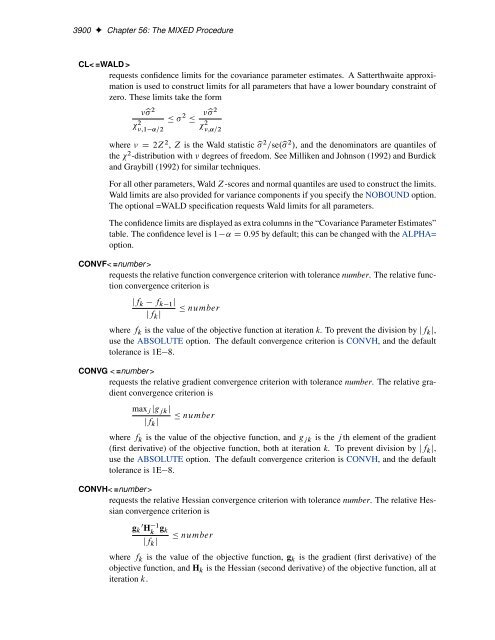SAS/STAT 9.2 User's Guide: The MIXED Procedure (Book Excerpt)
SAS/STAT 9.2 User's Guide: The MIXED Procedure (Book Excerpt)
SAS/STAT 9.2 User's Guide: The MIXED Procedure (Book Excerpt)
Create successful ePaper yourself
Turn your PDF publications into a flip-book with our unique Google optimized e-Paper software.
3900 ✦ Chapter 56: <strong>The</strong> <strong>MIXED</strong> <strong>Procedure</strong><br />
CL< =WALD ><br />
requests confidence limits for the covariance parameter estimates. A Satterthwaite approximation<br />
is used to construct limits for all parameters that have a lower boundary constraint of<br />
zero. <strong>The</strong>se limits take the form<br />
b2 2<br />
;1 ˛=2<br />
2<br />
b 2<br />
2<br />
;˛=2<br />
where D 2Z 2 , Z is the Wald statistic b 2 =se.b 2 /, and the denominators are quantiles of<br />
the 2 -distribution with degrees of freedom. See Milliken and Johnson (1992) and Burdick<br />
and Graybill (1992) for similar techniques.<br />
For all other parameters, Wald Z-scores and normal quantiles are used to construct the limits.<br />
Wald limits are also provided for variance components if you specify the NOBOUND option.<br />
<strong>The</strong> optional =WALD specification requests Wald limits for all parameters.<br />
<strong>The</strong> confidence limits are displayed as extra columns in the “Covariance Parameter Estimates”<br />
table. <strong>The</strong> confidence level is 1 ˛ D 0:95 by default; this can be changed with the ALPHA=<br />
option.<br />
CONVF< =number ><br />
requests the relative function convergence criterion with tolerance number. <strong>The</strong> relative function<br />
convergence criterion is<br />
jf k f k 1j<br />
jf kj<br />
number<br />
where f k is the value of the objective function at iteration k. To prevent the division by jf kj,<br />
use the ABSOLUTE option. <strong>The</strong> default convergence criterion is CONVH, and the default<br />
tolerance is 1E 8.<br />
CONVG < =number ><br />
requests the relative gradient convergence criterion with tolerance number. <strong>The</strong> relative gradient<br />
convergence criterion is<br />
maxj jg jkj<br />
jf kj<br />
number<br />
where f k is the value of the objective function, and g jk is the j th element of the gradient<br />
(first derivative) of the objective function, both at iteration k. To prevent division by jf kj,<br />
use the ABSOLUTE option. <strong>The</strong> default convergence criterion is CONVH, and the default<br />
tolerance is 1E 8.<br />
CONVH< =number ><br />
requests the relative Hessian convergence criterion with tolerance number. <strong>The</strong> relative Hessian<br />
convergence criterion is<br />
g k 0 H 1<br />
k g k<br />
jf kj<br />
number<br />
where f k is the value of the objective function, g k is the gradient (first derivative) of the<br />
objective function, and H k is the Hessian (second derivative) of the objective function, all at<br />
iteration k.

















